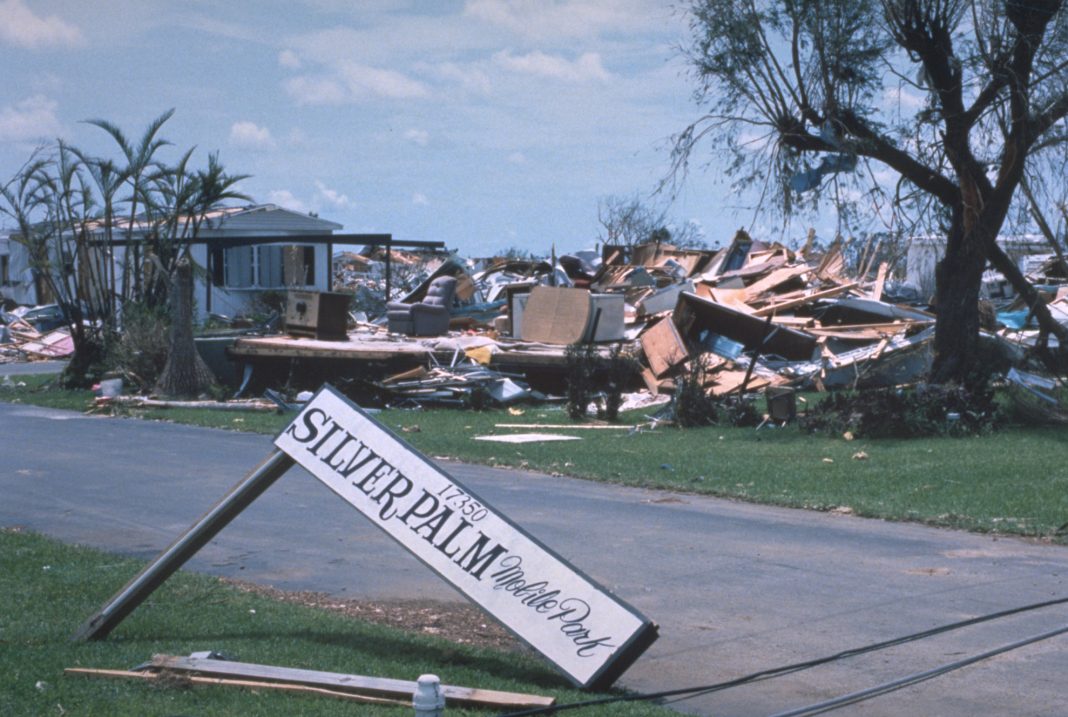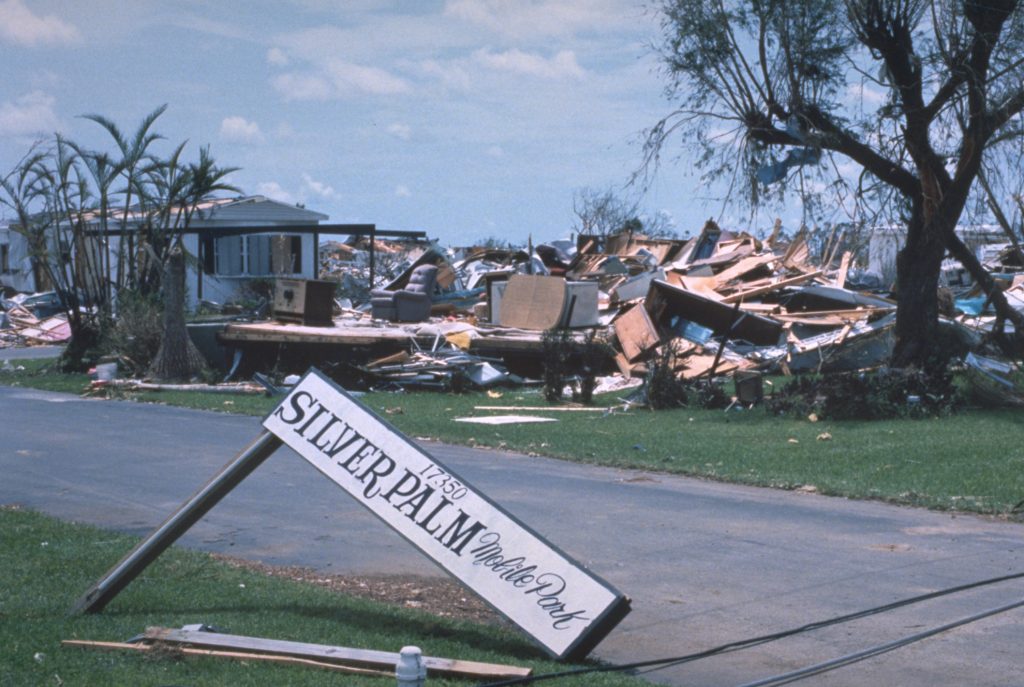

For the first three weeks after Hurricane Andrew, there was no electricity in Miami-Dade County (MDC). In the northern part of the county, buildings remained mostly intact, but trees laid across roads and yards, blocking emergency vehicles, repair services and pedestrians.
In the southern part, some houses only retained a single wall. Others completely blew away. At the time, it was the most expensive hurricane in US history, totaling 27 billion United States Dollars (USD) in damages, 57 billion USD in today’s dollars.
August 24th marks the 30th anniversary of the category five hurricane whose eye blew through the south of MDC before continuing West. The storm touched all of MDC, including the University of Miami.
Sylvia Thompson, a political science professor at UM, describes it as “the best of times” and “the worst of times.” She remembers her elderly neighbors in South Miami acting as crossing guards when the stoplights didn’t work due to power outages. Neighbors would fetch water for them.
Where Thompson lived, closer to the university, there was minimal property damage, but many of the area’s iconic centuries-old trees lay on the ground.
“You could actually drive through areas where you would think ‘where am I?’ because a lot of the landmarks were gone,” Thompson said, referring to the fallen trees.
She never expected the violent nature of the storm. The last category four hurricane to hit Miami occurred 42 years ago in 1950. The last category five was nearly 60 years ago.
“We were lulled into a sense of feeling safe,” Thompson said.
At UM, too, students and faculty didn’t expect the storm’s violence. While some evacuated, thousands of students and faculty sheltered in Stanford, Mahoney, Pearson, Eaton and Hecht residential colleges.
“I don’t think we had any indication even five days out that it could hit us in the way that it did,” said Patricia Whitely, senior vice president for student affairs who was the associate director for residential life and staff development at the time.
Andrew blew through the campus at 144 mph, beginning around midnight of the 24th and finishing at 7 a.m the same day.
Marc Caputo, a 1995 graduate of UM, was among the students sheltering. The university moved him and other students to the third and fourth floors of the now demolished Hecht Residential College.
“The storm was really howling,” Caputo said. “You could feel the building move.”
Caputo and his fellow residents finally emerged from the building the following day.
“It was just a different world at that point,” Caputo said.
The university sustained 13.5 million USD of damage, mostly to its trees, many of which the storm blew down.
With little electricity, concerns about running water and limited food available, the university encouraged students to fly home by discounting the cost of Delta, American and United flights from the following semester’s tuition.
In the aftermath of the storm, the school closed from August 28th to September 14th, delaying the start of classes by three weeks and changing finals’ schedules so that students took exams in class instead of during finals week.
Even once students returned, the remnants of Hurricane Andrew lingered.
On the way to class, Caputo would hear parrots squawking in the trees by the Ashe building, escapees of Parrot Jungle which Hurricane Andrew destroyed. He estimates that the university had returned to normalcy a year later.
Whitely and Thompson lauded then university president Tad Foote’s response.
“He did an amazing, amazing job and he should be credited for really getting this place back,” Whitely said.
Whitely recounted daily morning meetings between Foote and the faculty at the law school library as the university got back on its feet.
In the aftermath of Hurricane Andrew, the university realized it needed to plan for future hurricanes to avoid the kind of chaos that occurred in the subsequent weeks.
Now, hurricane awareness is a key part of students’ introduction to the university and there is a set action plan in place in the event of another hurricane. This includes mandatory evacuation procedures if the hurricane exceeds a category two and an established university shelter for students who may be unable to return home.
The university also maintains the Office of Emergency Management. Created in 2010, the office helps prepare the university for a myriad of disasters, hurricanes being among the most pertinent.
“The biggest impact that it had on, not only the county but the university and individuals like me, is we take hurricanes seriously,” Thompson said. “Pre Andrew, it seemed to me nobody paid any attention to what was happening during hurricane season.”
In the southern part of the county, the scene was radically different.
Thompson remembers hearing of looting in Homestead, the more heavily damaged southern part of the county. Blocked roads aggravated the issue, creating a temporary feeling of anarchy as public services could not reach the area.
Arthur Simon, a political science professor at UM, recalls Country Walk, a community close to the Everglades and south of the university. He used to campaign at a mobile-home park there during his time as a state legislator, going door to door seeking out votes.
He returned after Hurricane Andrew to find that it was gone.
“800 units completely wiped off of God’s green Earth,” Simon said. “We went to, physically, where it was and it was gone.”
In the week following Hurricane Andrew, Simon received the opportunity to survey the damage to Miami-Dade county in a helicopter tour alongside four CEOs of the top insurance companies in the country.
“Seeing mile after mile after mile, community after community after community of damage. It was just overwhelming,” Simon said.
The hurricane destroyed 25,524 Miami-Dade homes, leaving 250,000 homeless. Of those who lost their homes or needed support, 435 were UM faculty and staff.
“When you see these news clips where a tornado hits or even a hurricane hits, it shows you how bad it is. But usually it’s just a snapshot of a limited area,” Simon said. “Here, there’s complete devastation going over almost a half of the county.”
Shoddy building practices accentuated the disparity in the county. Buildings near Homestead were much newer, making them more vulnerable to the force of Hurricane Andrew. In the following years, legislators updated building codes to be much stricter.
Insurance discounts incentivized residents to retrofit their homes with hurricane windows and incorporate other structural support.
A burmese python breeding facility near the Everglades was among the affected buildings. With walls blown to the ground, non-native pythons escaped into the Everglades, initiating a now decades-old threat to the biodiversity of South Florida.
Top predators and evasive, Burmese pythons are prolific and difficult to eradicate. They’ve reduced the mammal population of the Everglades by 95%, preying on marsh rabbits, bobcats, deer and even panthers, who were once near extinction.
“The mammals that are being lost were an important part of the food web of the Everglades for thousands of years,” said Christopher Searcy, a biology professor at UM with expertise in conservation ecology for reptiles and amphibians. “We’ve disrupted that and it’s not clear that we’re ever going to be able to fix it.”
By reducing the import of foreign species as pets, Searcy says, South Florida can prevent another similar ecological disaster.
Since the future of hurricanes is so unpredictable, the best residents can do is prepare. According to the Office of Emergency Management, students and other residents can develop a family emergency plan, build a kit of essentials and stay informed on potential hurricanes.





